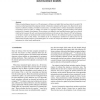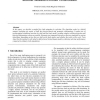202 search results - page 1 / 41 » Modeling collision avoidance behavior for virtual humans |
ATAL
2010
Springer
13 years 5 months ago
2010
Springer
In this paper, we present a new trajectory planning algorithm for virtual humans. Our approach focuses on implicit cooperation between multiple virtual agents in order to share th...
IVA
2010
Springer
13 years 3 months ago
2010
Springer
We present a velocity-based model for realistic collision avoidance among virtual characters. Our approach is elaborated from experimental data and is based on the simple hypothesi...
CGF
2000
13 years 4 months ago
2000
When articulated figures interact in a 3D environment, collisions are highly likely and must often be avoided. We present a method automatically producing realistic collision-free...
CGF
2002
13 years 4 months ago
2002
In this paper, we describe a method for cloth animation in real-time. The algorithm works in a hybrid manner exploiting the merits of both the physical-based and geometric deforma...
AGENTS
2000
Springer
13 years 8 months ago
2000
Springer
A crowd is not only a group of many individuals. Crowd modelling involves problems that arise only when we focus on crowds. For instance, avoiding collision problems related to a ...



